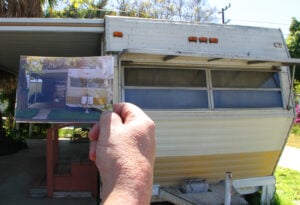
How many people can City Hall cram onto an acre of land? As many as it wants to.
Last Tuesday, "the pro-development majority on City Council" finally sealed the deal on a massive 341,290-square-foot, mega-development that is one of the worst developments ever approved in Santa Monica.
The East Village, a 377-unit mixed-use project, will replace the aging Village Trailer Park at 2930 Colorado Ave. Developer Marc Luzzatto bought the 3.8-acre mobile home park some six years ago and proposed replacing it with a mix of creative office space, market rate condominiums, apartments and retail uses. Major opposition came from the trailer park's residents.
Six years of wrangling ensued over the development's size and scale, relocation settlements for residents and the amount of low-income housing in the project. City Council approved a development agreement last November. Within weeks they reversed themselves when, after second thoughts, they decided they wanted more low-income units then were previously agreed upon.
The project went back to the drawing board and Luzzatto filed a $50 million lawsuit against City Hall in January claiming the council's reversal was illegal. Ultimately, a plan was worked out with the developer agreeing to build all 377 housing units as apartments and restricting 38 of them for very/extremely low-income tenants.
The agreement included retaining 10 mobile home spaces for current residents for 10 years and relocation payoffs for residents willing to leave. Major problems such as density, massing, intensification of use, traffic generation and overall architectural unattractiveness were largely ignored by staff and politicians alike who focused on low-income housing and remedies for those displaced.
Of course, East Village will also have the usual so-called "community benefits" including a recycling policy, transportation demand management program, underground parking for up to 799 vehicles, Colorado-fronting retail spaces, child care and senior contributions, pedestrian and bicycle friendly streets, wide sidewalks, landscaping, transit subsidies and a local hiring program for construction workers. Whoopee.
Despite promises of wall articulation and variable roof lines to break up building mass, the project is extremely dense and cramped with three, 57-foot-high (five floor) buildings. The project will generate an estimated 2,000 daily car trips.
Any similarities between East Village and tenements constructed at the beginning of the last century or the infamous early 1950s Pruitt-Igoe housing project in St. Louis, Mo. are purely coincidental.
The failed Pruitt-Igoe urban renewal project went into decline soon after it was opened and within 20 years, it had become a center for crime, grinding poverty and racial/economic segregation. Synonymous with incompetent planning and failed public policy, it was demolished in the ‘70s.
So, you're asking, "Hey Bill, is Luzzatto's development really going to turn into Pruitt-Igoe West?" Only time will tell but the ingredients are there.
For the record, Kevin McKeown, Tony Vazquez and Ted Winterer voted against it. Gleam Davis, Bob Holbrook, Terry O'Day and Mayor Pam O'Connor supported the development agreement. It's interesting to note how Davis has flip-flopped on voting for developments the last few months. How else is she going to keep those political contributions coming?
Rents are going up, way up
A troubling report issued by City Hall's Rent Control Administration indicates that when older apartments are voluntarily vacated, their rent levels dramatically increase. What was the once the backbone of the city's affordable housing stock is fast becoming out of reach for even moderate income folks.
For example, the monthly average rent (MAR) — excluding add-ons such as school or college tax and bond expense, rent control and other fees — for one-bedroom units jumped from $1,000 a month in 1999 to around $1,600 per month by 2012.
Two bedroom apartments that were $1,500 in 1999 were $2,700 per month in 2012. Three bedrooms units that rented around $1,750 in 1991 rose to more than $3,000 per month by 2012.
A 1999 state law (Costa-Hawkins), backed by landlords and real estate interests, mandated that voluntarily vacated apartments could be rented at market rates. Costa-Hawkins nullified a Santa Monica ordinance that kept vacated units at lower, rent-controlled rates.
Since then, over 63 percent of Santa Monica's rental units have had market rate increases at least once — increases that have far outpaced inflation. The report states that households of $100,000 or more in annual income constituted 23.6 percent of renters in 2000 and one-third of renters in 2012.
The real estate and development blog Curbed L.A. highlighted the problem in an April 4 post about the "exuberant Streamline Moderne" Voss Apartments at 947-953 11th St. Curbed noted that "Santa Monica's historic Voss Apartments were built in 1937. The 15-unit complex was owned by the same family for 75 years, but recently changed ownership."
It continues, "Perhaps coincidentally, a couple of apartments also recently became available; one, a studio, appears to have already been rented, but still up for grabs is a first-floor one-bedroom."
"Sadly, the Craigslist posting for the apartment is begrudging with both photos and details, saying only that the unit is ‘bright, clean & quiet with southern exposure, dining room, hardwood floors with beautiful interior details like curved ceilings and wall niches.' Monthly rent for the apartment, located two blocks south of Montana Avenue, is $2,395."
Are speculators buying up apartment buildings all over town, again? Are long-time, rent control tenants being bought out (or harassed out) for new, well-to-do tenants willing to pay triple the previous rents?
More on this in a future column
Bill can be reached at mr.bilbau@gmail.com.









